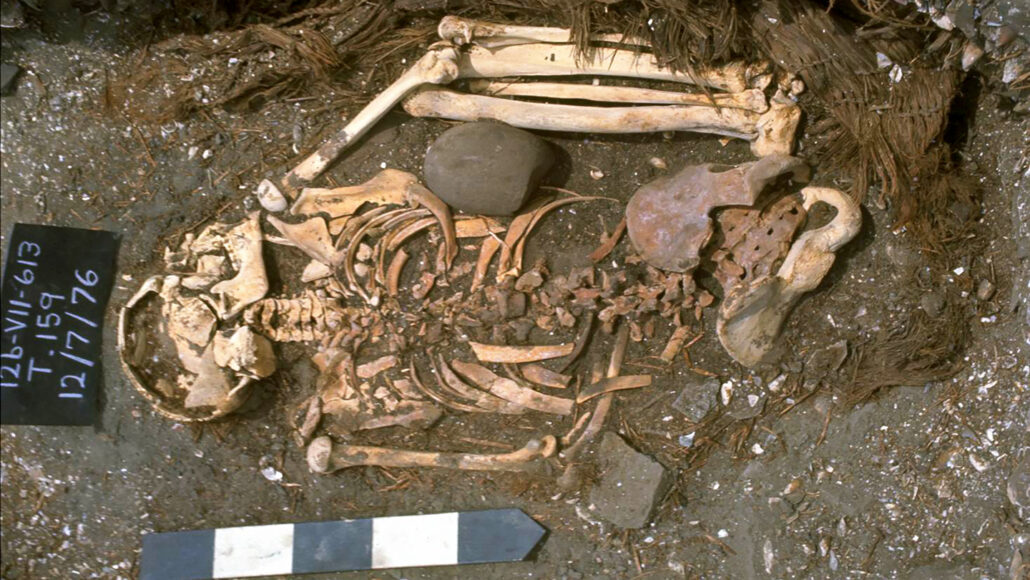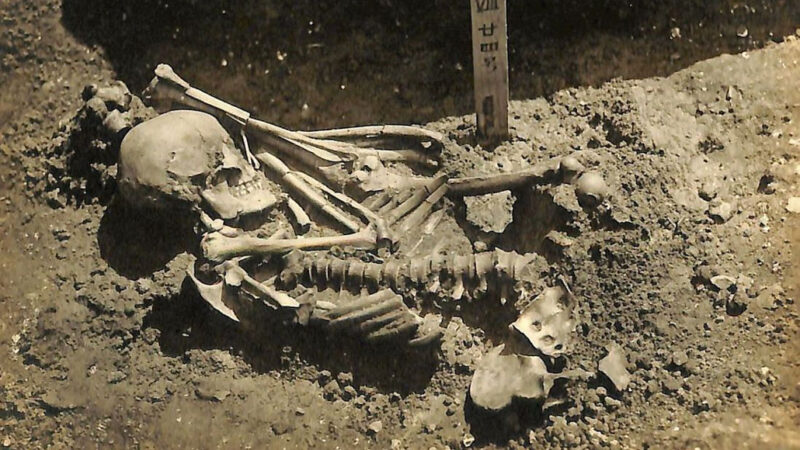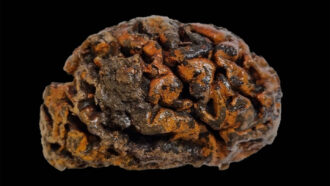Skeletons point to world’s oldest known shark attacks
These ancient victims had lived thousands of years ago and half a world apart

This roughly 6,000-year-old skeleton of a teenage boy from Peru appears to represent the oldest known case of a human killed by a shark.
J. Quilter
By Bruce Bower
Long ago, a shark attacked and killed a man off the southeastern coast of Japan. The victim had likely been fishing or shellfish diving. New radiocarbon dating places his death at between 3,391 and 3,031 years ago.
That makes this man from Japan’s ancient Jōmon culture the oldest known human victim of a shark attack, according to a new report. It appears in the August Journal of Archaeological Science: Reports.
But wait. Don’t rush to judgment, say two other archeologists. As soon as they heard of the new report, they recalled research they’d performed back in 1976. Both had taken part in the excavation of a roughly 17-year-old boy. His skeleton, too, bore signs of a fatal shark encounter. What’s more, that boy had died far earlier — some 6,000 years ago.
Until these now, a roughly 1,000-year-old skeleton had pointed to a fisherman in Puerto Rico as the earliest known shark victim. Now, in just a few short weeks, the historical record for shark attacks has been pushed back five millennia.
In ancient Japan
J. Alyssa White is an archaeologist at the University of Oxford, in England. In their recent August report, she and her colleagues described their new analysis of a partial 3,000-year-old skeleton. It had been unearthed around a century ago from a village cemetery near Japan’s Seto Inland Sea.
The bones recorded a grisly event. At least 790 gouges, punctures and other types of bite damage. Most marks on were on the Jōmon man’s arms, legs, pelvis and ribs.
The researchers made a 3-D model of the injuries. It suggests the man first lost his left hand trying to fend off a shark. Later bites severed major leg arteries. The victim would have died soon afterward.

His fishing comrades likely brought the man’s body back to land. Mourners placed the man’s mutilated (and probably detached) left leg onto his chest. Then they buried him. Lost in the attack were a sheared off right leg and left hand, the researchers say.
Numerous shark teeth at some Jōmon sites suggest these people hunted sharks. They may even have used blood to lure the sharks in close, while fishing at sea. “But unprovoked shark attacks would have been incredibly rare,” White says. After all, “sharks do not tend to target humans as prey.”
Half a world away . . .
Robert Benfer is a bioarchaeologist at the University of Missouri in Columbia. Jeffrey Quilter is an anthropological archaeologist at Harvard University in Cambridge, Mass. The boy’s skeleton they helped unearth in 1976 was missing its left leg. Hip and arm bones had deep bite marks. These were characteristic of those made by sharks, the scientists say.
“Successful shark bites usually involve tearing off a limb, often a leg, and ingesting it,” Benfer says. An unsuccessful attempt to ward off a shark presumably resulted in the boy’s arm injuries.
The teen’s 6,000-year-old remains were discovered at a Peruvian village site called Paloma. People had placed the body in a grave unlike any others in his community, says Benfer. He had directed investigations at the Paloma site in 1976 (and again during three more field seasons that concluded in 1990).
Quilter, his colleague, described the youth’s shark-related injuries in a 1989 book: Life and Death at Paloma. The passage was just two paragraphs long. The researchers never published their results in a scientific journal. So the boy’s shark wounds were essentially buried in 200-page book.
Quilter and Benfer e-mailed the excerpt to the Jōmon researchers on July 26. Says White, who led the new analysis of the Jōmon skeleton. “We were unaware of their claim until now.” But she said she and her team “are keen to speak to them about it in more detail.”
Paloma lies in hills about 3.5 kilometers (2.2 miles) from Peru’s Pacific coast. Small groups intermittently lived there around 7,800 and 4,000 years ago. Paloma’s residents primarily fished, harvested shellfish and gathered edible plants.
Most of the 201 graves unearthed at Paloma were dug up from beneath or just outside what would have been reed huts. But the young man with a missing leg was buried in a long, oval pit. People had dug into an open area and left the grave unfilled. Excavators found remains of a grid of canes that had been tied together and covered with several woven mats to form a cover or roof over the body. Items placed in the grave included a seashell, a large, flat rock and several ropes. One had fancy knots and a tassel at one end.







